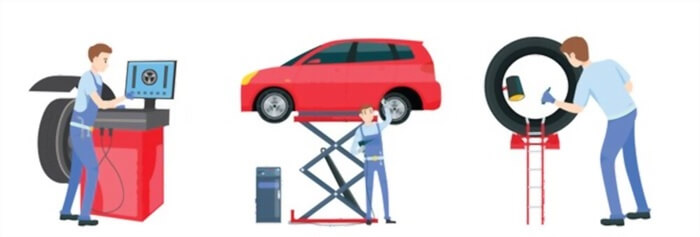Tire balancing helps ensure that your car tires function together correctly and offer you a smooth ride. However, how do you balance 35-inch tires? With big tires, things can go a little differently. They feel different and occasionally need a slight adjustment to feel just right.
How to Balance 35 Inch Tires
The quickest and best way to accurately balance a 35-inch tire is to use a balancing machine to determine where to place weights on your tires.
Even if you have to hire a service agency to balance the wheels for you, this is a more accurate method of determining the source of wobbling than using your eyes.
Attaching the weights is not too difficult in and of itself. One of the crucial things that must be done, whether you are fixing a clip or an adhesive-based weight, is to ensure that the outside room is clean. A clean tire will allow adhesive to adhere best, and a clip will have the best grip when it directly interacts with the rim.
Aside from that gear ratio is Important to perfect balancing. You can check the good gear ratio for 35 inch tires.
Does Balancing a 35-Inch Tire Work?
When installing balancers to a car tire, the tire’s size matters a little. In other words, the 35-inch tires can be balanced, although you may not experience the impact as intensely as you would on smaller tires.
Additionally, 35-inch tires are commonly utilized for mudding and off-roading. This increases the risk of the tire balancing weights being damaged or knocked off.
Often adhesive-based, weights run the risk of coming off and disappearing. Other popular weights are clip-on devices that can move under pressure and put pressure on the incorrect area of the tire.
Forcing a tire weight to remain on might be easier with locking beads.

Can Your Mechanic or a Local Tire Shop Balance 35-Inch Tires
They ought to be capable. However, some people say that stores may complain that balancing a larger tire is too challenging, particularly after some use.
The mechanics aren’t far off the mark because you might have to settle for something less than ideal because some tires have more significant problems with light and heavy areas that require an unusual combination of weights.
It might save you and the technician time if you let them know that you don’t anticipate the tires being correctly balanced.
Is There a Size and Balancing Restriction for Tires?
After 35 inches, tire balancing may call for more complex weight systems that are difficult to use but may be worthwhile, mainly if the vehicle is driven frequently. The potential consequences of persistently driving with an uneven weight distribution or having tires pop off the rims are more hazardous.
That does not suggest that a tire above 35 cannot be balanced. Simply put, you’ll need more knowledge, frequency, and work.
Why is Tire Balancing Important?
Balanced Tires Offer a Smoother Ride
Your vehicle will ride smoother as a result of having your tires balanced, which may be its biggest or at least most obvious advantage.
You can experience vibrations in your car as the weight on your tires shifts out of alignment. These vibrations become more noticeable when traveling at highway speeds.
Also, you may feel the steering wheel shake when driving down the highway. Balancing your tires may reduce or even eliminate these vibrations, providing you with a beautiful, smooth ride.
Balanced Tires Provide Better Fuel Efficiency
More than just your ride quality is enhanced by tire balancing. Your gas mileage may also increase.
If your tires are not balanced, they cannot drive uniformly. Your tires may deteriorate at various rates due to an uneven ride, lowering your total gas mileage.
Balancing your tires has the same positive impact on gas mileage as maintaining tire pressure. You may prevent wear that could lower your car’s fuel efficiency by ensuring weight is distributed equally across all four tires, ultimately saving you money.
Increase the Tires’ Lifespan
We just discussed how uneven tire wear results from unequal tires. In light of this, it should not be surprising that uneven wear and tear might shorten the lifespan of your tires.
Some tires may wear out more quickly when your tires are out of balance due to the high vibrations and uneven tread wear.
Protect Your Car’s Suspension
Unbalanced tires are terrible for more than just tread and gas mileage. It may also affect the suspension of your car.
The vibrations brought on by your out-of-balance tires will continue to worsen with time. These vibrations may eventually impact the suspension of your car. While balancing your tires is typically an easy task that costs less than $100, putting off the issue might result in far more costly problems in the future.
Enhance Your Ride Quality
Improving vehicle safety is the main advantage of having your tires balanced. Uneven tread wear and dangerous bald areas can appear in tires that are out of balance. This might make maneuvering your car more challenging, especially at high speeds.
Your car will always be in great shape if you perform routine maintenance tasks like tire balancing.
What is the Cost of Having Your Tires Balanced?
For four wheels, the cost of the necessary processes to balance out the tires might range from $15 to $80. The fee could change depending on the warranty, type of tires, location, and additional processes.
The typical cost is between $12 and $14 at a car dealership and roughly $10 per wheel at a tire shop. Some businesses will mount, balance, or rotate your tires for free if you purchase tires from them. Before making a purchase, inquire about any lifetime services the store may offer.
Can You Balance Tires at Home?
It is possible to balance your car tires at home with or without the balancers. However, this requires you to be aware of the mechanical parts of the wheel and the car.
If You Have Oversized Tires Watch This Video
Final Take
We hope after reading this article, you are now aware of the best way to balance your 35-inch tires. Balancing your tires has several benefits, as discussed above. Thus, it is always important to have your tires balanced whenever you notice they are out of alignment.
